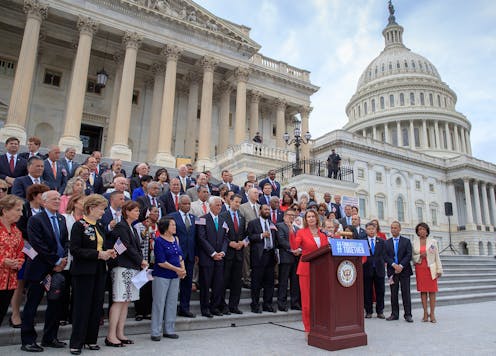2 economic policies likely to change with Democrats in control of House
While a divided Congress will likely mean gridlock, there are two economic policies likely to see significant change: trade and infrastructure.

Perhaps the biggest surprise in the midterm elections was that, unlike 2016, there wasn’t one. Polls and pundits expected Democrats would take control of the House and Republicans would keep the Senate, and that’s exactly what we are getting.
The likely result: two years of congressional gridlock on economic policy, which requires both houses of Congress to agree on the same legislation. So, we can expect that the status quo on economic policy will mostly prevail.
There are, however, two economic issues on which the election outcome will make a meaningful difference: trade and infrastructure.
NAFTA lives
One of the first items of business in January after the new Congress gets sworn in will be the United States-Mexico-Canada Trade Agreement.
The deal is intended to replace NAFTA, which President Donald Trump has threatened to withdraw from for several years. In reality, the new deal is little more than a slightly modified version of its would-be predecessor.
But before it can become the law of the land, Congress must ratify it, either by a majority vote by both houses or two-thirds of the Senate.
The USMCA’s chances were already far from assured before the Democrats took the House. Now its failure is very likely.
So what happens next?
The simple answer is not much. NAFTA remains in force. Ultimately I believe that’s a good thing for the U.S. economy because the new deal would likely shift auto industry jobs to Mexico.
With any luck, the USMCA defeat also convinces Trump to have second thoughts about his costly trade war.
But what if he tries to follow through on his threat to withdraw from NAFTA? Fortunately, most constitutional scholars say he can’t do so unilaterally. Were he able to, however, the consequences for the U.S. economy would be severe.
Roads, bridges and bipartisanship
Infrastructure, on the other hand, offers a rare opportunity for House Democrats and Trump to find common ground.
The signs of a crisis in America’s infrastructure are unmistakable: derailing and delayed trains, crumbling roadways, collapsing bridges, undrinkable tap water and a wastewater system that is a menace to public health.
The American Society of Civilian Engineers estimated that America’s “D+” infrastructure costs an average household US$3,400 annually. It also cost lives, as it did when a Minnesota bridge collapsed in 2007, killing 13.
In February, Trump proposed a fund to spend $1.5 trillion to fix the infrastructure mess, with the government putting up $200 billion and the private sector kicking in the rest.
While Democrats support infrastructure spending, the stumbling block in the Trump plan was the provision that the private sector would effectively own the roads and bridges that it builds.
While House Democrats may not support this plan, they would likely be willing to support something that mainly relies on just federal spending. And Republicans have a reason to go along as well: Infrastructure spending would boost economic growth, which is forecast to slow in 2019 – just before the 2020 elections.
While a few hundred billion dollars in spending won’t solve the U.S. infrastructure problem, it would be a good start. It would stimulate the economy and also make everyone’s lives more pleasant and less expensive – and may even end a little gridlock (pun intended).
Steven Pressman does not work for, consult, own shares in or receive funding from any company or organization that would benefit from this article, and has disclosed no relevant affiliations beyond their academic appointment.
Read These Next
Where the wild things thrive: Finding and protecting nature’s climate change safe havens
Protecting places that are likely to remain cool and moist as global temperatures rise can save wildlife…
Billionaires with $1 salaries – and other legal tax dodges the ultrawealthy use to keep their riches
The richest Americans can largely avoid paying income and other taxes. A new book explains the history.
The US already faces a health care workforce shortage – immigration policy could make it worse
About 1 in 4 doctors practicing in the US were born abroad.





